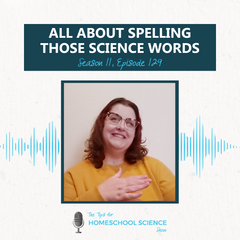FREE Shipping on all our products! (Please Note: Orders may experience a delay of a week or more in shipping due to the high volume of orders at this time of year.)
FREE Shipping on all our products! (Please Note: Orders may experience a delay of a week or more in shipping due to the high volume of orders at this time of year.)
The fully-stocked home science laboratory {Episode 6}
June 13, 2016 2 min read
The fully-stocked home science laboratory {Episode 6}
Before you start teaching science at home, do you really have to buy a full set of glassware, chemicals, and equipment? In this episode, Paige is going to show you how you can have a fully-stocked home science laboratory without breaking the bank!
Watch the Video
Subscribe to the Elemental Science YouTube Channel, so you won't miss another video!
Or Listen to the Audio
Don't miss an episode - subscribe to the Teaching Science at Home Show through iTunes and Stitcher!
The Highlights
The number three struggle I hear when it comes to teaching science at home is equipment.
You can use coffee mugs, Ball glass jars, straws, and coffee filters as a substitute for expensive labware.
Kitchen Chemicals
You already have chemicals sitting on your pantry shelf and many of these are weaker, and a bit safer, than their lab counterparts.
- Acids – Swap in lemon juice, soda, or vinegar.
- Bases – Substitute baking soda, ammonia, or bleach.
- Indicator – Test acids and bases with cranberry juice or red cabbage juice.
- Crystals – Use salt, sugar, borax, or Epsom salts.
- Battery – Start with a lemon or a potato.
- Polymer – Make borax slime or a bio-plastics.
Microscopes
When purchasing a microscope for homeschool use, look for the following specs:
- A compound monocular microscope;
- A microscope with 4x, 10x, and 40x objective lenses at a minimum (Note: The eyepiece should also give 10x magnification, which then will allow you to look at an object at 40x, 100x, and 400x magnification.);
- A microscope with separate coarse and fine adjustment knobs;
- A good light source. (Note: The best light sources are a LED or cool fluorescent bulb. Do not get one with mirror illumination as they are very difficult to adjust.)
Get more information about choosing a microscope and using one in your home from Paige's blog.
If you can’t afford a microscope, you can:
- Google it – “(subject name) microscope image” (or check out the Sassafras Microscope Pinterest board)
- Use a palm-sized substitute (currency or jeweler’s scope)
A bit of Kitchen Science Fun
And just for fun, here's how you can...
- Extract DNA from your kitchen,
- Make a non-Newtonian fluid from your pantry,
- And do chromatography from your hall closet.
Learn more about how you can teach science with our programs!
Also in {Podcast} The Tips for Homeschool Science Show
All About Spelling Those Science Words {Season 11, Episode 129}
March 25, 2024 7 min read

In this episode, we'll be interviewing Robin Williams from All About Spelling. Click "Read More" to listen is as we discuss tips and tricks for spelling all those science words!
How should you handle notebooking through the different ages? {Season 11, Episode 128}
March 18, 2024 3 min read

Writing in Science with a Well-Trained Mind (Interview) {Season 11, Episode 127}
March 11, 2024 16 min read

Click "Read More" to listen in as Susan Wise Bauer and Susanna Jarret join Paige to share tips and tools about the third key to teaching science!
Subscribe
Sign up to get the latest on sales, new releases and more …

